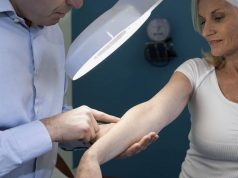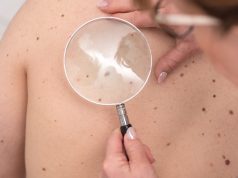Chemiexcitation is a slow process; “an evening-after” sunscreen possible prevention
FRIDAY, Feb. 20, 2015 (HealthDay News) — Skin damage caused by ultraviolet (UV) radiation continues long after sun exposure, even in the dark, according to a study published in the Feb. 20 issue of Science.
Researchers exposed mouse and human melanocytes to UV radiation. In melanocytes with melanin, DNA damage occurred not only immediately, but also hours after UV exposure ended. In melanocytes that didn’t have melanin, the damage occurred only during UV exposure.
It was thought that melanin protected the skin by blocking UV light, but this study found that melanin has both protective and harmful effects. “If you look inside adult skin, melanin does protect against cyclobutane pyrimidine dimers. It does act as a shield. But it is doing both good and bad things,” said study author Douglas Brash, Ph.D., in a Yale University School of Medicine news release. Brash is a clinical professor of therapeutic radiology and dermatology at Yale.
Scientists explained the process that caused DNA-related damage in the dark. UV light activated enzymes that stimulated melanin. This process, called chemiexcitation, created the same DNA damage in the dark that sunlight caused in daytime, according to the researchers. Chemiexcitation is a slow process and it may be possible to develop ways to prevent it, such as “an evening-after” sunscreen that might be able to block the transfer of damaging energy to the skin cells, the researchers said.
Abstract
Full Text (subscription or payment may be required)
Copyright © 2015 HealthDay. All rights reserved.








